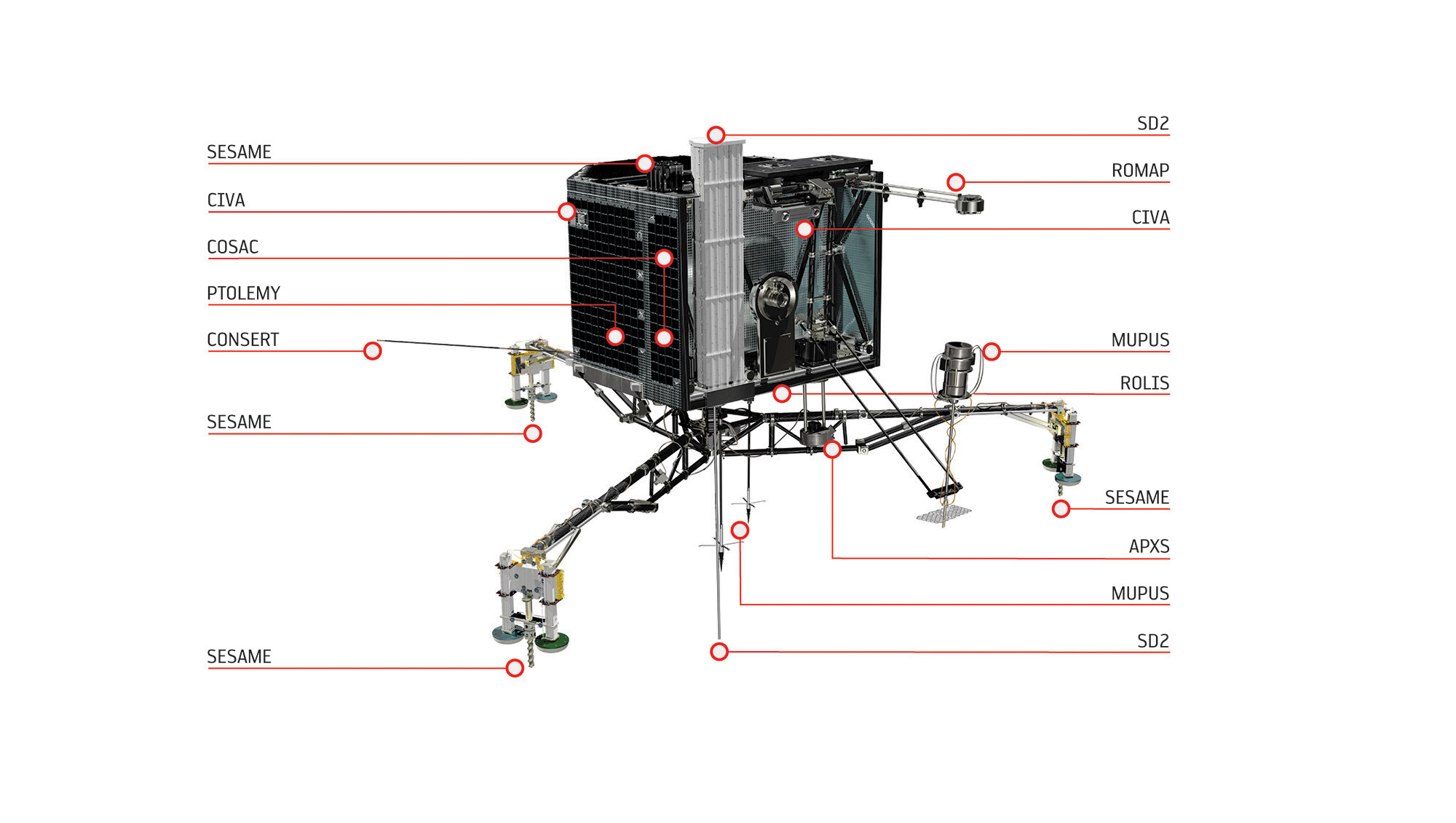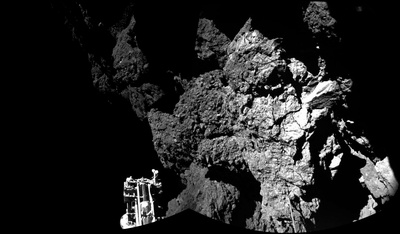Waiting for a signal from Philae
It would be very lucky if a signal were to be received from Philae at 05:00 CET on 12 March 2015. The lander finally came to rest on 12 November 2014 in a rather shaded location on Comet 67P/Churyumov-Gerasimenko and it needs to receive sufficient energy before it can wake up and begin communicating. This is, however, the first possibility to receive a signal from Philae; therefore, the communication unit on the Rosetta orbiter will be switched on to call the lander.
“Philae currently receives about twice as much solar energy as it did in November last year,” says Lander Project Manager Stephan Ulamec from the German Aerospace Center (Deutsches Zentrum für Luft- und Raumfahrt; DLR).
Today, Comet 67P/Churyumov-Gerasimenko, Rosetta and Philae are 320 million kilometres from the Sun.
“It will probably still be too cold for the lander to wake up, but it is worth trying. The prospects will improve with each passing day,” says Ulamec.
Waking up at the right temperature and energy
Several conditions must be met for Philae to start operating again and allow the DLR Lander Control Center to put it to work. First, the interior of the lander must be at least at –45ºC before Philae can wake up from its winter sleep. At its new landing site – Abydos – only a little sunlight reaches Philae, and the temperatures are significantly lower than at the originally planned landing location. In addition, the lander must be able to generate at least 5.5 watts using its solar panels to wake up. It has not remained idle during hibernation.
“Philae is designed so that, since November 2014, it has been using all the available solar energy to heat up,” says Koen Geurts from the DLR Control Center.
As soon as Philae ‘realises’ that it is receiving more than 5.5 watts of power and its internal temperature is above –45ºC, it will turn on, heat up further and attempt to charge its battery.
Contact during comet daytime
Once awakened, Philae switches on its receiver every 30 minutes and listens for a signal from the Rosetta orbiter. This, too, can be performed in a very low power state.
“At this time, we do not yet know that the lander is awake,” says Geurts. “To send us an answer, Philae must also turn its transmitter – and that requires additional power.”
It could be that the lander has already woken up from its winter sleep some 500 million kilometres away from Earth, but does not yet have sufficient power to communicate with Rosetta, which relays Philae’s signal back to Earth. Philae needs a total of 19 watts to begin operating and allow two-way communication.
Between 12 and 20 March, the Rosetta orbiter is transmitting to the lander and listening for a response. The most likely time for contact is during the 11 flybys where the orbiter’s path puts it in a particularly favourable position with respect to the lander during comet ‘daytime’ – when Philae is in sunlight and being supplied with power by its solar panels. Communication will be attempted continuously because Philae’s environment could have changed since landing in November 2014.
Preparation for all eventualities
So far, Philae’s exact location has not been identified on images acquired by the Optical, Spectroscopic, and Infrared Remote Imaging System (OSIRIS) on board the Rosetta orbiter, so the operations team at DLR is currently working with the information they have from the lander’s cameras: the Comet nucleus Infrared and Visible Analyser (CIVA) and the ROsetta Lander Imaging System (ROLIS), along with the knowledge gained from the solar energy conditions experienced in November.
“However, we assume that the solar panels of Philae are shadowed but, by what, we cannot see in the previous images,” says Geurts.
The DLR engineers have therefore sent new commands to the lander that optimise the heating and provide energy savings to improve its chances of communication with Earth. Even if Philae does not have enough energy yet to answer, it could receive and execute these commands. This is referred to as ‘blind commanding’ by the engineers, because the lander is initially very unlikely give them feedback. These procedures were tested on the ground model at the DLR Microgravity User Support Center (MUSC). Even in the event that the rechargeable battery on board Philae did not survive the cold phase, the engineers are prepared.
“We are working to ensure that we can operate the lander and its instruments at least during the comet’s daytime, when it is in direct sunlight,” says Geurts.
Waiting for the health check
Once Philae wakes up and can also transmit, it will first send data about its ‘health’ to Earth.
 |
| Philae's instruments. Credits: ESA/ATG medialab |
“We will then evaluate the data. What is the state of the rechargeable battery? Is everything on the lander still functioning? What is the temperature? How much energy is it receiving?” says Geurts.
The scientific work with the 10 instruments on board Philae also depends on these results. If sufficient energy cannot be stored in the battery, the solar energy available during the comet daytime will determine whether a reduced version of the measurements can be performed. Currently, scientists believe that Philae is in sunlight for 1.3 hours. A day on 67P/Churyumov-Gerasimenko lasts 12.4 hours. If the battery can be charged as planned, measurements can be carried out during the comet night, enabling, for example, long-term measurements. What instrument is used and when will be determined by the team of scientists.
“If we cannot establish contact with Philae before 20 March, we will make another attempt at the next opportunity,” says Ulamec. “Once we can communicate with Philae again, the scientific work can begin.”
As the distance to the Sun decreases, the energy that the lander collects with its solar panels is becoming greater.

